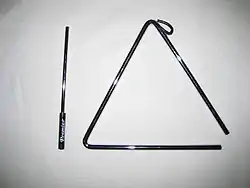Triangle (musical instrument)
The triangle is an idiophone type of musical instrument in the percussion family. It is a bar of metal, usually steel but sometimes other metals such as beryllium copper, bent into a triangle shape. The instrument is usually held by a loop of some form of thread or wire at the top curve.[1] While the triangle theoretically has a definite pitch, it is obscured by the overtones that are produced when struck.[2]
 | |
| Classification | Hand percussion, idiophone |
|---|---|
| Hornbostel–Sachs classification | 111.211 Individual percussion sticks |
History
The triangle evolved from the Egyptian sistrum and, like its predecessor, the triangle was largely used for religious purposes.[3] These earlier triangles often had three jingles strung upon the lower bar producing a continuous jingle when struck. This design may have persisted well into the era of Mozart and Beethoven. It was not until the early 19th century where the rings vanished and the triangle developed its clear tone that is known by today.[4]
The triangle is considered a tool to polish the melody with a bright and clear sound. Especially in contemporary work, the triangle's beauty has been further discovered and has been more widely used from chamber music to orchestral works.
Shaping and manufacturing
The triangle is shaped as its namesake though one of the angles is left open, with the ends of the bar not quite touching. This opening is used to keep the instrument from having a definite pitch, creating many rich overtones.[5] It is either suspended from one of the other corners by a piece of, most commonly, nylon fishing line, leaving it free to vibrate. It is usually struck with a metal beater, giving a high-pitched, ringing tone.
Although today the shape is generally in the form of an equilateral triangle, early instruments were often formed as non-equilateral isosceles triangles.
Early examples of triangles include ornamental work at the open end, often in a scroll pattern. Historically, the triangle has been manufactured from solid iron and later steel rod and bent into a triangular shape roughly equilateral. In modern times, the scroll pattern has been abandoned and triangles are made from either steel or brass.[6]
Technique
The triangle is often the subject of jokes and one liners as an archetypal instrument that seemingly has no musical function and requires no skill to play (the Martin Short character Ed Grimley is an example). However, triangle parts in classical music can be very demanding, and James Blades in the Grove Dictionary of Music and Musicians writes that "the triangle is by no means a simple instrument to play".
A triangle roll, similar to a snare roll, is notated with three lines through the stem of the note. It requires the player to quickly move the wand back and forth in the upper corner, bouncing or "rolling" the wand between the two sides.
Most difficulties in playing the triangle come from the complex rhythms which are sometimes written for it, although it can also be quite difficult to control the level of volume. Very quiet notes can be obtained by using a much lighter beater: knitting needles are sometimes used for the quietest notes. Composers sometimes call for a wooden beater to be used instead of a metal one, which gives a rather "duller" and quieter tone. When the instrument is played with one beater, the hand that holds the triangle can also be used to damp or slightly modify the tone. For complex rapid rhythms, the instrument may be suspended from a stand and played with two beaters, although this makes it more difficult to control.
Musical styles
Classical music
.jpg.webp)
In European classical music, the triangle has been used in the western classical orchestra since around the middle of the 18th century. Wolfgang Amadeus Mozart, Joseph Haydn and Ludwig van Beethoven all used it, though sparingly, usually in imitation of Janissary bands.[7] The first piece to use the triangle prominently was Franz Liszt's Piano Concerto No. 1 in E♭ major, where it is used as a solo instrument in the third movement, giving this concerto the nickname of "triangle concerto".[8] In Romantic era music, the triangle was used in some music by Richard Wagner, such as the "Bridal Chorus" from Lohengrin. Johannes Brahms uses the triangle to a particular effect in the third movement of his Fourth Symphony.
Folk and popular music
.jpg.webp)
In folk music, forró, Cajun music and rock music a triangle is often hooked over the hand so that one side can be damped by the fingers to vary the tone. The pitch can also be modulated slightly by varying the area struck and by more subtle damping.
The triangle (known in Cajun French as a ‘tit-fer, from petit fer, "little iron") is popular in Cajun music where it serves as the strong beat, especially if no drums are present.[9]
In the Brazilian music style Forró it is used together with the zabumba (a larger drum) and an accordion. It forms together with the zabumba the rhythmic section. It provides usually an ongoing pulse, damping the tone on the first second and fourth while opening the hand on the third beat to let most frequencies sound. It can be used though extensively for breaks and to improvise to vary the rhythm.
Notes
- "Percussion Instruments".
- "Triangle | musical instrument".
- James, Blades (1992). Percussion Instruments and Their History (Rev. ed.). Westport, Conn.: Bold Strummer. p. 191. ISBN 0933224710. OCLC 28230162.
- Beck, J. H. (2013). Encyclopedia of Percussion. United States: Taylor & Francis. (pg. 397)
- "Triangle, Philharmonia Orchestra".
- Grover, Neil, Whaley, Garwood. "About the Triangle".
- Peinkofer, Karl, Tannigel, Fritz (1976). Handbook of Percussion Instruments. European Amer Music Dist Corp.
- Mordden, Ethan (1986). A Guide to Orchestral Music: The Handbook for Non-musicians. Oxford University Press. p. 183. ISBN 9780195040418.
- "Louisiana Voices Glossary" (Under definition for Tit-fer). Retrieved 2008-03-08.